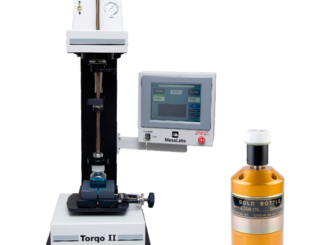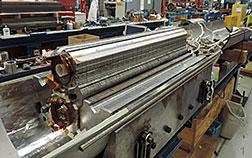
Muon g-2 experiment.
Two years ago, scientists on the Muon g-2 experiment successfully brought a fragile, expensive and complex 17-ton electromagnet on a 3,200-mile land and sea trek from DOE’s Brookhaven National Laboratory in New York to Fermi National Accelerator Laboratory in Illinois.
Now, the magnet is one step closer to serving its purpose as the centerpiece of an experiment to probe the mysteries of the universe with subatomic particles called muons. The ring—now installed in a new, specially designed building at Fermilab—was successfully cooled down to operating temperature (-450°F) and powered up, proving that even after a decade of inactivity, it remains a vital and viable scientific instrument.
Getting the electromagnet to this point took a team of dedicated people more than a year. The magnet was built at Brookhaven in the 1990s for a similar muon experiment. Before the move to Fermilab, it spent more than 10 years sitting in a building, inactive.
Moving the ring from New York to Illinois was a tricky proposition. Scientists sent the ring on a fantastic voyage, using a barge to bring it south around Florida and up a series of rivers to Illinois. A specially designed truck (see three-minute video) gently drove it the rest of the way to Fermilab. The 52-foot-wide magnet, essentially three rings of aluminum with superconducting coils inside, could neither be taken apart nor twisted more than a few degrees without causing irreparable damage.
Over the past year, workers took on the painstaking task of reassembling the magnet’s steel base. (Watch two-minute time lapse video.) Two dozen 26-ton pieces of steel—and a dozen 11-ton pieces—had to be maneuvered into place with tremendous precision. “It was like building a 750-ton Swiss watch,” said Fermilab’s Chris Polly, project manager for the Muon g-2 experiment.
While that assembly was taking place, other members of the team had to completely replace the control system for the magnet, redesigning it from scratch.
Bringing the ring down to its operating temperature of -450°F required cooling it with a helium refrigeration system and liquid nitrogen for more than two weeks. Once cooling was complete, the ring had to be powered with 5,300 amps of electric current to produce the desired magnetic field.
The next step for the magnet is a long process of “shimming,” or adjusting the magnetic field to within extraordinarily small tolerances. Fermilab is also constructing a beamline that will provide muons to the new Muon g-2 experiment.
Scientists expect to start measuring and analyzing those muons in 2017.



